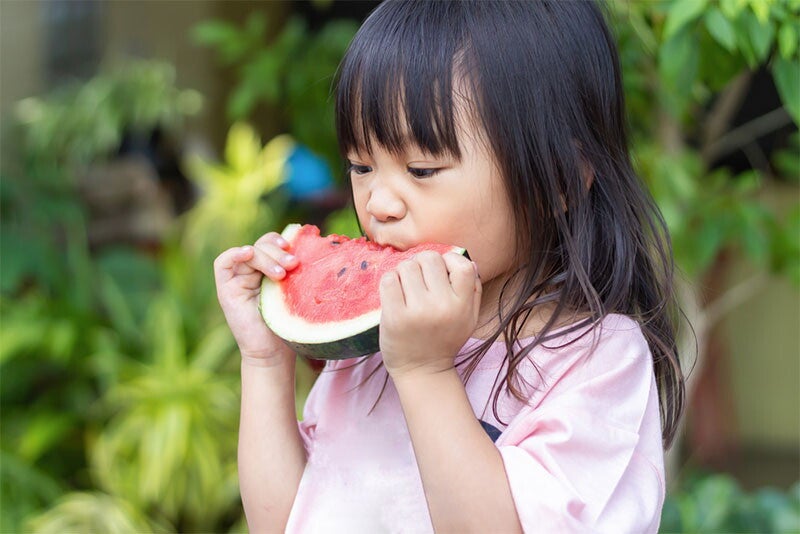
Prebiotics vs. Probiotics: Which One Is Better for Your Child?
You're probably aware now more than ever that the gut plays an influential role in your child's health. And that's why the conversation about prebiotics vs. probiotics matters.
They're often mentioned in the same breath, but prebiotics and probiotics play different roles in keeping your child healthy. Here's how they work together for your child's nutrition and wellness.
Prebiotic vs. Probiotic
Although the "versus" may suggest they oppose each other, these gut-friendly ingredients work as a team. You'll understand this better once you learn the difference between prebiotics and probiotics. One nourishes the beneficial microbes, while the other consists of the good bacteria itself.
What are probiotics?
The International Scientific Association for Probiotics and Prebiotics (ISAPP) defines probiotics as live microorganisms that, when consumed in the right amounts, can support your child’s health.
Known as good bacteria, probiotics work alongside the trillions of microbes already living in your child’s gut (known as the gut microbiota). They can produce beneficial compounds, encourage the growth of friendly bacteria, and crowd out harmful microbes.
Probiotics are classified by their genus, species, and strain. They include:
- Lacticaseibacillus or Lactobacillus
- Bifidobacterium
- Lactococcus
- Carnobacterium
- Enterococcus
- Streptococcus
- Pediococcus
- Propionibacterium
- Leuconostoc
- Bacillus species
- Saccharomyces yeasts
- Aspergillus molds
The strain is crucial because it can produce different health effects, even among the same species. ISAPP states that only bacteria scientifically proven to be beneficial can be called probiotics.
What are prebiotics?
Unlike probiotics, prebiotics are not living organisms but a special type of dietary fiber you can naturally find in fruits, vegetables, and other plant foods. They nourish the good microbes already living in your child’s gut, especially in the colon, and other helpful strains like Lactobacillus and Bifidobacterium.
You can find prebiotics on ingredient labels under names like:
- Fructooligosaccharides (FOS)
- Galactooligosaccharides (GOS)
- Human milk oligosaccharides (HMO)
- Inulin
- Oligofructose (OF)
- Chicory fiber
- Lactulose
- Resistant starch
Benefits of Probiotics

Studies show that children at risk of antibiotic-associated diarrhea may benefit from probiotics.
Scientists still have much to discover how probiotics affects a child's overall well-being. So far, the research has shown the following potential benefits.
Manages acute diarrhea in children
The European Society for Paediatric Gastroenterology, Hepatology, and Nutrition (ESPGHAN) states that strains, such as Lacticaseibacillus and Saccharomyces boulardii, can shorten the duration and lessen the severity of sudden diarrhea caused by infections in children.
Reduces antibiotic-related tummy troubles
Antibiotics can mess with the intestinal microbiome, putting children who take them at risk of antibiotic-associated diarrhea (AAD). ESPGHAN recommends Saccharomyces boulardii or Lacticaseibacillus rhamnosus GG to prevent AAD to reduce the likelihood of this side effect and help restore the gut microbiome balance.
Soothes colic in babies
A 2025 clinical study in Cureus found that babies given the probiotic Limosilactobacillus reuteri (L.reuteri) cried significantly less compared to those who didn’t get the probiotic. Parents also noticed less burping, fussiness, and facial redness, all common signs of colic. In fact, many babies in the probiotic group had their crying time cut in half.
L.reuteri is also the strain shown to promote an increased frequency of bowel movements among children suffering from constipation.
Supports lactose digestion
Adding probiotics to your child's diet may be helpful if they have dairy sensitivity. According to a Journal of Dairy Research review, products containing strains like Lactobacillus acidophilus may help reduce lactose-intolerance symptoms, such as bloating, gas, and diarrhea.
Minimizes the risk of eczema
An extensive review in the American Journal of Clinical Dermatology looked at nearly 7,000 babies and kids to see if probiotics could help prevent eczema or atopic dermatitis. These children were given probiotics either before birth (through their mothers) or after birth for several months.
Taking probiotics on both occasions showed kids had a lower risk of developing eczema compared to those who didn’t take any. Taking them during just one of those periods wasn't as effective.
Benefits of Prebiotics
As for prebiotics, research shows these possible advantages:
Supports a healthy digestive system
Since they feed good bacteria, ISAPP shares prebiotics have the potential to promote regular bowel movements, ease constipation, and prevent diarrhea, especially after antibiotics. They may also aid the fermentation process in the colon, producing short-chain fatty acids (SCFAs) like butyrate, which are essential for a healthy intestinal lining and digestion.
Strengthens the body’s natural defenses
A review in the Pediatric Gastroenterology Hepatology & Nutrition (PGHN) cites evidence that prebiotics could strengthen your child's gut barrier. This means more balanced immune responses and compounds that fight inflammation. All of this leads to a stronger immune system, which lowers your child's chances of getting infections.
Helps improve mineral absorption
Several studies suggest that certain prebiotic fibers could make it easier for your child’s body to absorb key minerals like calcium, magnesium, and iron. This matters a great deal during the growing years when every nutrient counts toward healthy bones and development.
Shows potential for allergy prevention
While further research is needed, studies included the PGHN review suggest that prebiotics may play a role in reducing the risk or severity of allergies, especially for children who are at high risk.
Supports appetite and energy balance
ISAPP says prebiotic foods may help your child manage their hunger and use energy better by boosting the gut-brain connection. This can affect how full they feel after meals and how their body regulates blood sugar, which is crucial for maintaining a healthy weight.
Best Sources of Prebiotic and Probiotic Foods

Prebiotics vs. probiotics aside, a well-balanced diet should take care of your child's gut health in the long term.
You don't need to get into a prebiotic vs. probiotic debate during meal planning. You can make room for both.
Where to find probiotics
Most commercial probiotic foods and drinks typically contain strains from the Lactobacillus and Bifidobacterium genera. You'll find them in:
- Yogurt with live cultures
- Fermented milk drinks
- Supplements
ISAPP emphasizes that the amount of probiotics in a product matters. However, keep in mind that it doesn't always mean the higher the probiotic levels, the bigger the benefits. The group's advice: Choose a strain or strain blend backed by science. Be mindful also of the sugar content in probiotic drinks.
Where to find prebiotics
If you're breastfeeding, congratulations! Your breast milk already provides your child with a rich source of HMO prebiotics.
Not all dietary fibers are prebiotics. Those that are classified as probiotic sources include:
- Asparagus
- Atis (custard apples)
- Baked beans
- Beetroot
- Cashews
- Chickpeas
- Cooked potatoes
- Garlic
- Granada (pomegranate)
- Green and snow peas
- Oats
- Onion
- Pakwan (watermelon)
- Rambutan
- Suha (grapefruit)
- Unripe bananas
In commercial products, check the label and look for mention of the specific prebiotic ingredient, like inulin, FOS, or GOS.
When's the Best Time to Take Prebiotics and Probiotics?
For both prebiotics and probiotics, there isn't a recommended "best time" unless your child is taking them to manage diarrhea or combat the effects of antibiotics. In these cases, follow your doctor's instructions.
If you're looking to maintain a healthy tummy for your child, you can include prebiotic-rich foods in your child's meals at any time. Then, add a probiotic drink before or during breakfast.
As for prebiotic vs. probiotic supplements, always ask your child's pediatrician about the need, frequency, and duration.
Should Kids Take Prebiotics and Probiotics?
Most research indicates that there is nothing wrong with children taking prebiotics and probiotics, mainly if they're obtained from real food. Your child's tummy may even benefit, especially if they have specific digestive issues or are taking antibiotics.
If your child experiences gas or bloating, start with small amounts to allow their gut to adapt. An article in the American Academy of Pediatrics says prebiotics are consumed by the good bacteria in the gut, and any extra passes through and exits with the stool. The same goes for probiotics; if there’s more than your child’s gut can handle, the excess moves through the digestive system without causing harm.
Your child's gut and all the microbes that live there make your little one unique. Since probiotics and prebiotics aren't one-size-fits-all, they may not be effective for every child.
Read the labels and check with your pediatrician to find the right fit for your child’s needs. When it comes to prebiotics vs. probiotics, there's really no competition to create a healthy environment of good gut bacteria.
Head to ParenTeam's Moms and Dads Facebook group and let's talk about all the ways to help our kids maintain a healthy tummy!
References
ISAPPScience, “What Is a Probiotic? ISAPP Educational Video,” September 25, 2019, https://www.youtube.com/watch?v=C6j7F-JhtmQ
ISAPPScience. “What Is a Prebiotic? ISAPP Educational Video,” September 25, 2019. Accessed June 25, 2025. https://www.youtube.com/watch?v=bBrLqkpMlw8
Collinson, Shelui, Andrew Deans, April Padua-Zamora, Germana V Gregorio, Chao Li, Leonila F Dans, and Stephen J Allen. “Probiotics for Treating Acute Infectious Diarrhoea.” Cochrane Library 2020, no. 12 (December 8, 2020). https://doi.org/10.1002/14651858.cd003048.pub4
Davani-Davari, Dorna, Manica Negahdaripour, Iman Karimzadeh, Mostafa Seifan, Milad Mohkam, Seyed Masoumi, Aydin Berenjian, and Younes Ghasemi. “Prebiotics: Definition, Types, Sources, Mechanisms, and Clinical Applications.” Foods 8, no. 3 (March 9, 2019): 92. https://doi.org/10.3390/foods8030092
Department of Gastroenterology, School of Translational Medicine. “Dietary Fibre and Natural Prebiotics for Gut Health: FAQs.” Monash University. Accessed June 25, 2025. https://www.monash.edu/medicine/translational/gastroenterology/prebiotic/faq
Dong, Mingyang, Yuting Wu, Mengzhen Zhang, Pengjun Chen, Zhiyang Zhang, and Shu Wang. “Effect of Probiotics Intake on Constipation in Children: An Umbrella Review.” Frontiers in Nutrition 10 (September 1, 2023). https://doi.org/10.3389/fnut.2023.1218909
Miqdady, Mohamad, Jihad Al Mistarihi, Amer Azaz, and David Rawat. “Prebiotics in the Infant Microbiome: The Past, Present, and Future.” Pediatric Gastroenterology Hepatology & Nutrition 23, no. 1 (January 1, 2020): 1. https://doi.org/10.5223/pghn.2020.23.1.1
Pujari, Radha, and Gautam Banerjee. “Impact of Prebiotics on Immune Response: From the Bench to the Clinic.” Immunology and Cell Biology 99, no. 3 (September 30, 2020): 255–73. https://doi.org/10.1111/imcb.12409
Zhou, Pengjun, Chunlan Chen, Sandip Patil, and Shaowei Dong. “Unveiling the Therapeutic Symphony of Probiotics, Prebiotics, and Postbiotics in Gut-immune Harmony.” Frontiers in Nutrition 11 (February 8, 2024). https://doi.org/10.3389/fnut.2024.1355542




























